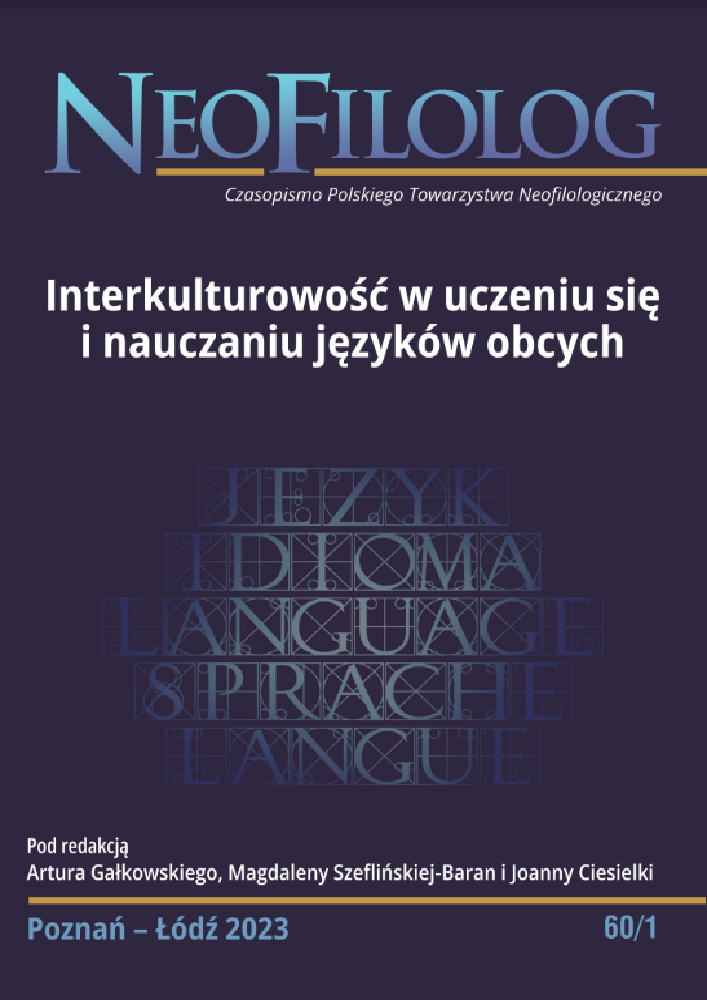Bibliografia
Balboni P. (2014), Didattica dell’italiano come lingua seconda e straniera. Torino: Bonacci.
Balboni P., Caon F. (2015), La comunicazione interculturale. Venezia: Marsilio Elementi.
Beacco J.-C. (2013), Articuler les compétences langagières et les compétences culturelles / interculturelles dans l’enseignement des langues, (w:) Claudel C. i in. (red.), Cultures, discours, langues. Nouveaux abordages. Limoges: Éd. Lambert-Lucas, s. 165–185.
Buttjes D., Byram M. (red.) (1991), Mediating Languages and Cultures: Towards an Intercultural Theory of Foreign Language Education. Clevedon: Multilingual Matters, s. 136–158.
Caon F., Spaliviero C. (2015), Educazione letteraria, linguistica, interculturale: intersezioni. Torino: Bonacci-Loescher.
Council of Europe: Coste D. i in. (2003), Europejski system opisu kształcenia językowego: uczenie się, nauczanie, ocenianie. Warszawa: CODN.
Crozet C., Liddicoat A. J., Lo Bianco J. (1999), Intercultural Competence: From Language Policy to Language Education, (w:) Crozet C., Liddicoat A. J., Lo Bianco J. (red.), Striving for The Third Place: Intercultural Competence through Language Education. Melbourne: Language Australia, s. 1–20.
Crozet C., Liddicoat A. J. (1999), The Challenge of Intercultural Language Teaching: Engaging with Culture in the Classroom, (w:) Crozet C., Liddicoat A. J., Lo Bianco, J. (red.), Striving for The Third Place: Intercultural Competence through Language Education. Melbourne: Language Australia, s. 113–126.
Defays J-M. (2011), Interculturalité et didactique des Langues, (w:) Defays J-M. (red.), Plurilinguisme et diversité culturelle dans les relations internationales. Points de vue russes et belges francophone. Bruxelles: Éditions Modulaires Européennes, s. 45–64.
Ennis M. J., Riley C. E. (2017), Practices in Intercultural Language Teaching and Learning. Newcastle upon Tyne: Cambridge Scholars Publishing.
Gajos M. (2010), Voici… Édith Piaf. Odsłony z życia Édith Giovanny Gassion. Łódź: Dom Wydawniczy Księży Młyn.
Gajos M. (2017), Les non-dits dans les programmes et les manuels de FLE. „Acta Universitatis Lodziensis. Folia Litteraria Romanica”, nr 12, s. 293–302. DOI: https://doi.org/10.18778/1505-9065.12.25
Grucza S. (2020), Lingwistyczne podstawy badań specjalistycznej komunikacji międzykulturowej, (w:) Buras-Marciniak A., Goźdź-Roszkowski S. (red.), Języki specjalistyczne w komunikacji interkulturowej. Łódź: Wydawnictwo Uniwersytetu Łódzkiego, s. 11–20. DOI: https://doi.org/10.18778/8220-071-3.02
Janowska I., Bodzioch M. (2016), Trening akulturacyjny a rozwijanie interkulturowej kompetencji komunikacyjnej. „Neofilolog”, nr 46/2, s. 221–233. DOI: https://doi.org/10.14746/n.2016.46.2.06
Liddicoat A. J., Crozet C. (red.) (1997), Teaching Language, Teaching Culture. Canberra: Applied Linguistics Association of Australia. DOI: https://doi.org/10.1075/aralss.14
Muller C. (2014), Interculturalité: Débusquer les stéréotypes dans les manuels. „Les langues modernes”, nr 2, s. 66–72.
Puren Ch. (2005), Interculturalité et interdidacticité dans la relation enseignement – apprentissage en didactique des langues-cultures. „Études de linguistique appliquée”, nr 4 (140), s. 491–512. DOI: https://doi.org/10.3917/ela.140.0491
Sercu L. (2005), Foreign Language Teachers and Intercultural Competence: An Investigation in 7 Countries of Foreign Language Teachers’ Views and Teaching Practices. Bristol: Multilingual Matters. DOI: https://doi.org/10.21832/9781853598456
Spychała M. (2014), Znaczenie interkulturowej kompetencji komunikacyjnej i negocjacyjnej w procesie przyswajania języka obcego, (w:) Spychała M. (red.), Nauczanie i uczenie się języka hiszpańskiego i włoskiego. Lublin: Instytut Filologii Romańskiej KUL i WERSET, s. 22–31.
Vedovelli M., Casini S. (2016), Che cos’è la linguistica educativa? Roma: Carocci. Wierzbicka A. (1985), Different cultures, different languages, different speech acts.
„Journal of Pragmatics”, nr 9, s. 145–178.
Wilczyńska W., Mackiewicz M., Krajka J. (2019), Komunikacja międzykulturowa: wprowadzenie. Poznań: Wydawnictwo UAM.
Zarate G. (1986), Enseigner une culture étrangère. Paris: Hachette.
Zarzycka G. (2021), Glottokulturoznawstwo (także polonistyczne) jako jeszcze jedna subdziedzina naukowa glottodydaktyki, (w:) Lipińska E., Seretny A. (red.), Dydaktyka języka polskiego jako nierodzimego: konteksty – dylematy – trendy. Kraków: Universitas, s. 313–340.
Zarzycka G. (2019), Kulturemy polskie – punkty widzenia, techniki ich wydobywania i negocjowania. Stosowanie perspektywy etnolingwistycznej w glottodydaktyce polonistycznej. „Acta Universitatis Lodziensis. Kształcenie Polonistyczne Cudzoziemców”, nr 26, s. 425–441. DOI: https://doi.org/10.18778/0860-6587.26.29
Licencja
Prawa autorskie (c) 2023 Artur Gałkowski, Magdalena Szeflińska-Baran, Joanna Ciesielka

Utwór dostępny jest na licencji Creative Commons Uznanie autorstwa – Bez utworów zależnych 4.0 Międzynarodowe.
Przedstawiany utwór (artykuł) upubliczniany jest na podstawie umowy z autorem i na licencji Creative Commons Attribution-NoDerivatives 4.0 International (CC BY-ND 4.0).
Użytkownicy mają obowiązek podania wraz z rozpowszechnionym utworem, informacji o autorstwie, tytule, źródle (odnośniki do oryginalnego utworu, DOI) oraz samej licencji;
- bez tworzenia utworów zależnych,
- utwór musi być zachowany w oryginalnej postaci.
Uniwersytet im. Adama Mickiewicza w Poznaniu zachowuje prawo do czasopisma jako całości (układ, forma graficzna, tytuł, projekt okładki, logo itp.).

